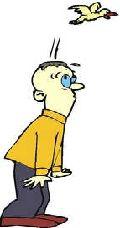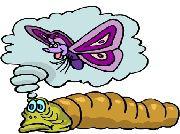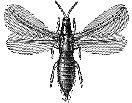Natural Solutions to Things That Bug You (4 page)
Read Natural Solutions to Things That Bug You Online
Authors: Myles Bader

It is first necessary to study the damage and solve the mystery. If the plants leaves are full of holes, the type of hole and its shape may give you a clue. The plant may be cut off at the base and pulled underground. The leaves may be chewed around the edges or there may be a small hole in the stem. Was the damage done during the day or during the night?
A careful study of the surroundings and the underneath side of the leaf is important to see if the culprit has left behind a clue to its identity. Many insects lay their eggs on the underneath sides of leaves and the color of the eggs can be another clue.

Droppings from insects and critters are an excellent clue to follow up; however, you must narrow the possibilities down so that you can attack the pest with the most efficient natural means available.
If the ground is moist you may be able to find tracks, which are an excellent method of identification. If you do find out that it is a night intruder than you will need to check the garden after dark with a flashlight. Many insects can be caught in the act after dark, which makes identifying them much easier.
The damage, however, may not be done by insects and may be caused by animals in which case you will have to approach the problem from a totally different angle. There are many methods of eliminating the problem such as trapping, spraying, use of pathogens, placing barriers, glue strips, baiting or parasites may be used. Initially trapping is one of the best methods of identifying the pest or pests.
This book provides many methods of solving insect and bug problems and you can pick the best method for your yard that will cause the least amount of damage to your healthy plants.
Identification may include bringing a sample of the problem to your local garden or agricultural supply store. In some cases you may have to bring the sample to a local college or university entomologist.
BEETLES
 Almost 40% of all insects are beetles! They can be found everywhere except in the oceans. They are easily recognized wing covers, which meet in a straight line down the middle of their backs. Most beetles are unable to, or rarely fly. If they do fly, they may tend to bump into things since they have very poor eyesight.
Almost 40% of all insects are beetles! They can be found everywhere except in the oceans. They are easily recognized wing covers, which meet in a straight line down the middle of their backs. Most beetles are unable to, or rarely fly. If they do fly, they may tend to bump into things since they have very poor eyesight.
 The larvae of beetles, is called a “grub.” Grubs develop below ground and are usually pale white and have well, developed front legs used for digging. They have very strong jaws and have the ability to chew and cause extensive damage. The larval form has three pairs of legs on the thorax and can be found on the surface or on the plants. The bodies of bark beetle larvae look like a piece of puffed rice and have a dark colored head.
The larvae of beetles, is called a “grub.” Grubs develop below ground and are usually pale white and have well, developed front legs used for digging. They have very strong jaws and have the ability to chew and cause extensive damage. The larval form has three pairs of legs on the thorax and can be found on the surface or on the plants. The bodies of bark beetle larvae look like a piece of puffed rice and have a dark colored head.
CATERPILLARS/BUTTERFLIES/MOTHS

 The immature or larval stages are called caterpillars and have three pairs of claw-like legs on their thorax. They also have fleshy legs known as prolegs on a number of their segments. To identify this caterpillar from others each have 2-5 pairs of prolegs that are tipped with a crochet tip. The cycle goes from the egg stage to 5 stages of caterpillar then to a butterfly or moth. The eggs are always laid on a leaf.
The immature or larval stages are called caterpillars and have three pairs of claw-like legs on their thorax. They also have fleshy legs known as prolegs on a number of their segments. To identify this caterpillar from others each have 2-5 pairs of prolegs that are tipped with a crochet tip. The cycle goes from the egg stage to 5 stages of caterpillar then to a butterfly or moth. The eggs are always laid on a leaf.
LACEWINGS/ANTLIONS
 This is a group of predators that have curved, lance-like jaws that project prominently from their head. The larvae have legs on the thorax but do not have prolegs on the abdomen. Lacewings have a tendency toward cannibalism, which forces the female to lay each egg on the end of a hair-like strand, which separates them at birth, thus protecting them. Lacewings may be considered a beneficial insect and loves to consume aphids.
This is a group of predators that have curved, lance-like jaws that project prominently from their head. The larvae have legs on the thorax but do not have prolegs on the abdomen. Lacewings have a tendency toward cannibalism, which forces the female to lay each egg on the end of a hair-like strand, which separates them at birth, thus protecting them. Lacewings may be considered a beneficial insect and loves to consume aphids.
ANTS/BEES/WASPS/SAWFLIES

 The larval stage is difficult to identify and are not easily found since they develop in specialized nests that are somewhat unique to each species. However, bees, wasps and sawflies; can be identified by their two pairs of transparent wings. Flies have only one pair of wings.
The larval stage is difficult to identify and are not easily found since they develop in specialized nests that are somewhat unique to each species. However, bees, wasps and sawflies; can be identified by their two pairs of transparent wings. Flies have only one pair of wings.
Ants: can be easily recognized by their enlarged abdomen.
FLIES/GNATS/MOSQUITOES
 The larvae of true flies do not have any legs and thus making it difficult to identify a head. The head is usually tapered to a point and surrounded by tiny hooks that can be retracted. The larval form is called a “maggot” and is produced by flies. The larval form of mosquitoes also lacks legs; however, they have a visible head that is darker than the rest of the body.
The larvae of true flies do not have any legs and thus making it difficult to identify a head. The head is usually tapered to a point and surrounded by tiny hooks that can be retracted. The larval form is called a “maggot” and is produced by flies. The larval form of mosquitoes also lacks legs; however, they have a visible head that is darker than the rest of the body.
THRIPS
 The main difference between the adult thrip and the larval stage is the absence of wings. The larval stage and the adult are often found together on plants. Thrips are so small that they are almost invisible and about the width of a fine sewing needle. They damage the plant by sucking the sap out by scrapping the tissue. The plant damage; is sometimes mistaken for damage by mites, except there are no webs.
The main difference between the adult thrip and the larval stage is the absence of wings. The larval stage and the adult are often found together on plants. Thrips are so small that they are almost invisible and about the width of a fine sewing needle. They damage the plant by sucking the sap out by scrapping the tissue. The plant damage; is sometimes mistaken for damage by mites, except there are no webs.
